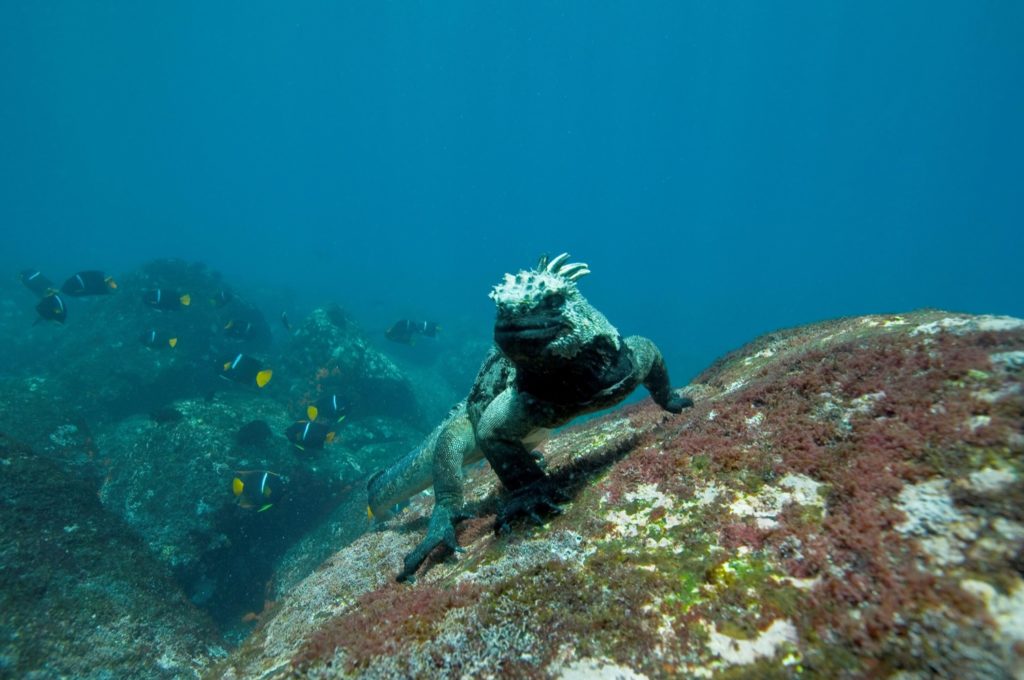The much-maligned marine iguanas of the Galápagos Islands are so famously homely, and can be described as “hideous-looking” and “most disgusting, clumsy lizards.” In fact, the iguanas are not pretty with their wide-set eyes, ugly faces, spiky dorsal scales, and knotty, salt-encrusted heads. The marine iguana has the ability, unique among modern lizards, to forage in the sea, and can dive, more than 30 feet into the water.
It is sometimes called Galápagos marine iguana and lives on the rocky Galápagos shore but also be spotted in marshes and mangrove beaches. Marine iguanas are medium-sized lizards almost 200 to 340 mm, however, vary in body size, which is different depending on the island the individual iguana inhabits. The adult males’ weigh is falling between 12 to 13 kg varying due to algal productivity and sea surface temperature
Though, these strange creatures lack in looks they make up for with their astonishing and exclusive ecological adaptations. Scientists have different thoughts that land-dwelling iguanas from South America have drifted out to sea millions of years ago on logs or other debris ultimately landing on the Galapagos. Indeed their appearance is fierce, in contrast to actually having gentle herbivores, surviving exclusively on underwater algae and seaweed.
Marine iguanas are sexually dimorphic with adult males weighing around 70% more than adult females and having a correlation between longevity and body size. The large adult males’ body size is selected sexually, suffering higher mortality than females and smaller adult males. The Amblyrhynchus cristatus lacks agility on land but is a graceful swimmer, and mortality rates are, in fact, explained through the size difference between the sexes.
The species emerged marine iguanas spread to nearly all the islands of the archipelago, hosting marine iguanas of exclusive size and shape, and color. Moreover, the strange creature’s short, blunt snouts and small, razor-sharp teeth help them scrape the algae off rocks, and flattened tails let them move crocodile-like through the water. Even though, their claws are long enough and sharp for clinging to rocks onshore or underwater in heavy currents.
The population of ugly lizards is not confirmed yet but can be judged by hundreds of thousands. The marine iguana starts reproduction in cold and dry seasons; female marine iguanas sexual maturity starts 3 to 5 years, however, males reach sexual maturity at the age of 6 to 8 years. Female laid eggs 1 to 6 and which take 3 months to incubate. The eggs lie in nests dug 30 to 80 cm deep in sand or volcanic ash.
The iguanas have dark gray coloring to better absorb sunlight after their forays into the frigid Galapagos waters. Therefore, they even have distinct glands that clean their blood of extra salt, which they ingest while feeding. The specie is under continuous pressure from non-native predators like rats, feral cats, and dogs, who feed on their eggs and young.
They are endangered throughout the archipelago and are considered vulnerable to extinction. Marine iguanas sneeze habitually to expel salt from glands close they’re noses. The salt often lands on their heads, giving them a unique white wig. The marine iguana forages exclusively on inter-and subtidal algae, and 4 to 5 red algal species are their food of choice, however, varies in accordance to the algal abundance, preferences, and foraging behavior.
The marine iguana is an ectothermic animal, that spends limited time in cold water, and afterward basks in the sun to warm up. Their dark color shades also support them in heat reabsorption. Moreover, the specie fights sometime during the breeding season but are usually harmless; and they’ll bob their heads as a threat and if the other suitor responds, both will thrust their heads together until one backs away.
The Marine Iguana is presently labeled as vulnerable in its conservation status and its population has been gradually decreasing throughout the years due to natural predators’ defenses needed to help protect them against new enemies. The marine iguana has developed over time in a fairly safe environment and thus does not have a very strong immune system.
Also Read: The Red-billed Streamertail
Source: National Geographic & Wikipedia













